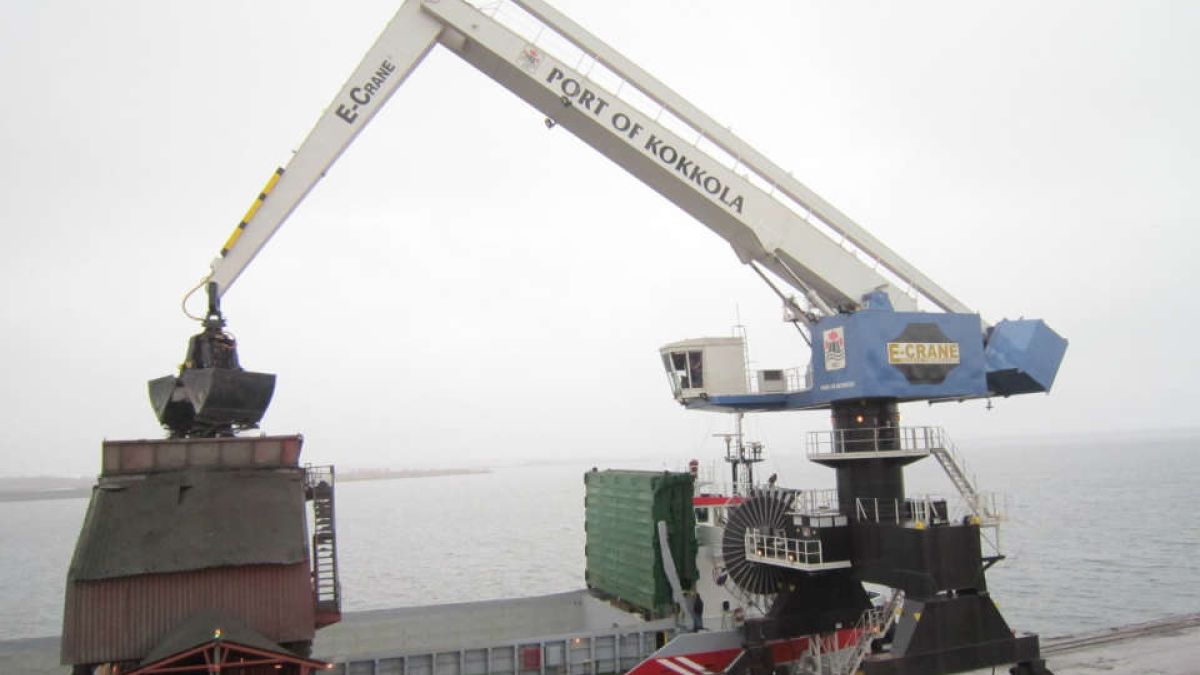
New 2000-Series E-Crane for Port of Kokkola completes cargo handling facilities
Off to a quick start…

Having successfully completed the advanced training program, all E-Crane certified crane operators familiarized themselves within an hour with the new E-Crane’s systems. After this brief introduction operators assisted with the soft loading of dark bulk material (iron ore oxide) into a large handy class vessel (shore-to-ship operation). This first job was completed swiftly and with great comfort so it was time to move to the next and more demanding job: offloading zinc concentrate from a coaster into the existing dockside travelling hopper (ship-to-shore operation).
Efficiency and Productivity go Hand in Hand
Immediately after the offloading of zinc concentrate into the 14 meter (!) high hopper started, cycle times in a 40 to 45 seconds window were observed. Using the 7,5 m3 grab this resulted in a net payload of zinc concentrate between 14 and 16 tons (!) and peak offloading capacities in the 1150 to 1300 tons per hour range. As the operators’ skills with this new piece of equipment will certainly further improve and as dock management will gain experience and know-how with the logistics up and around the E-Crane, all involved in this new and exciting project are convinced that the E-Crane will contribute to the further successful development of Kokkola’s Deep Port activities and the long-term profitability of the port.
At E-Crane State-of-the-art technology simplifies the operation and maintenance of complex equipment

The operators also extensively tested the ‘semi-automatic offloading’ option of the crane because the ship-to-hopper operation is a perfect application for this feature. Rather quickly it showed that the use of the semi-automatic cycle option resulted in improved operator comfort combined with good cycle times. However, and this was no surprise, the experienced crane driver could still out-perform the crane’s computer systems. In order to greatly increase serviceability, POK’s E-Crane has remote connectivity (tele-servicing) capabilities and this means that E-Crane service engineers can remotely connect from around the world to trouble-shoot, resolve problems, assist with the repairs of the crane and provide the necessary support during regular service intervals without having to travel to the job-site.
E-Crane would like to use this opportunity to pay a tribute to the dedicated work by and excellent cooperation with the staff of the Port of Kokkola during many technical meetings, during the dock-side installation, during the commissioning process, the testing, tuning and start-up of the crane and finally during the commissioning phase.
For all who have spent day and night in turning this exciting project into a success, this work has also been an opportunity to get to know each other better and build close personal ties. E-Crane particularly congratulates Mr. Torbjörn Witting, Port Director, and Mr. Tapio Lampinen, Technical Manager, and their team for the support and hard work and we wish them fair winds and following seas with this new E-Crane.
Lieven Bauwens – ir. Managing Director / E-Crane Worldwide
About Port of Kokkola
Today the Port of Kokkola has commercial links to countries and places all over the world, and cargoes provided both by local customers and by the transit traffics pass through the port.
The Port of Kokkola is the largest of the four major ports located along the coast of Ostrobothnia. As a result of the largest investment ever the fairway leading into the Port of Kokkola now has a draft of 13 meters. Due to this improvement, Kokkola is one of Finland’s three deep-water ports. Panamax size vessels can now safely enter the port fully loaded. Dry and liquid bulk cargoes, containers and general cargoes provided by both local and transit customers are handled in the port.
Massive investments have also been made in the cargo handling equipment and the port installations, contributing to the increase of the cargo handling capacity from 3 million tons in the beginning of the 1990-ies to today’s 7 million tons. The port can offer a wide range of both covered and open storage areas, and additional facilities are constantly built, whenever required. A total of 529 vessel called the port in 2001 to load or discharge metals, concentrates, talcum, chemicals, liquid bulk cargoes, zinc, sawn timber, general cargo and containers.
Excellent railway lines connect Kokkola to the Murmansk area, the Kola Peninsula and further to the Komi Area and other far-away destinations in Western Siberia. The road and rail connections to other parts of Russia are also very good and competitive. In addition to the specialized dry bulk and sawn timber traffics, liner traffics link Kokkola to the UK (Immingham) and to the main ports of the European Continent (Hamburg, Rotterdam and Antwerp).